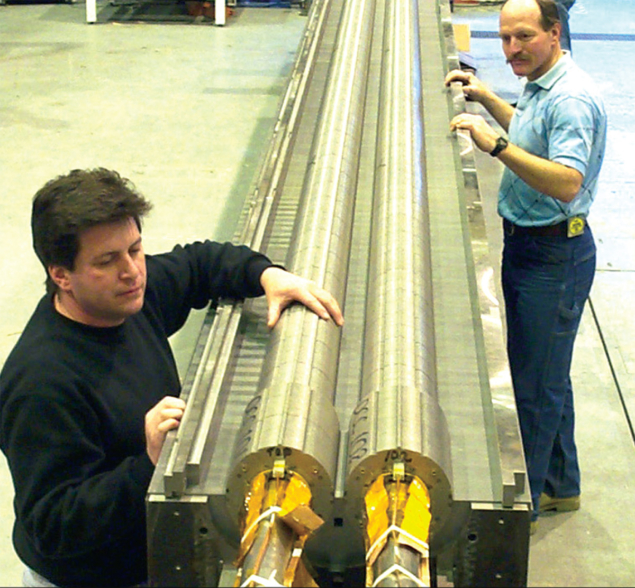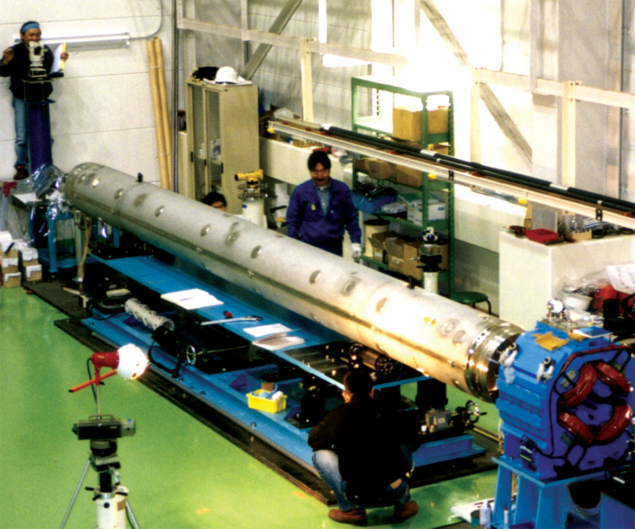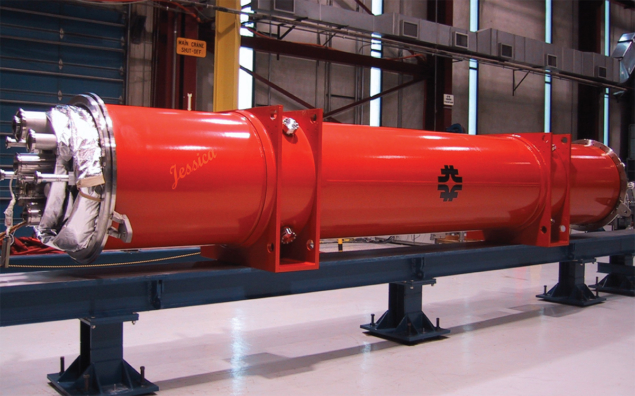In October 2001, production of the specialised magnets that perform specific tasks, such as final focus, and injection and extraction of beams, was in full swing. The magnets would soon be installed in the eight “insertion regions” between the LHC’s arcs.

When the machine runs in collider mode, one should forget the lattice,” said Norbert Siegel. “Where it all happens is at the interaction points.” Siegel is leader of the CERN group responsible for Large Hadron Collider LHC superconducting magnets other than those of the machine’s main lattice. Like other accelerators and colliders, the LHC’s magnets can be divided into two categories. Lattice magnets keep protons on course and are responsible for maintaining stable circulating beams. The rest go by the name of insertion magnets, performing specific tasks such as final focus before collision, beam cleaning, injection and extraction.
Inner triplets
For the LHC, the most complex insertion magnets are the eight so-called inner triplets that will squeeze the proton beams and bring them into collision in the centre of the four LHC experiments. The inner triplets are placed symmetrically at a distance of 23 m on either side of the interaction points, and each forms a cryogenic unit about 30 m long. They consist of four low-beta quadrupole magnets, so-named because their job is to minimize the beta-function, which is proportional to beam size, at the interaction point. Because of the special job they have to do and their proximity to the interaction points, the inner triplet magnets will be subject to unusually high heat loads. This means that a superfluid helium heat exchanger of unprecedented scale is required to keep them at their 1.9 K operating temperature.

The inner triplets are being provided as part of the US and Japanese contributions to the LHC project. They will use two types of quadrupole, along with various corrector magnets that are being supplied by CERN. One type of quadrupole is being developed at Japan’s KEK laboratory, the other at the US Fermilab, which also has the task of integrating all of the components into their cryostats. After a successful development programme using short model magnets, full- size low-beta quadrupoles have been made and were tested in May.
The first piece of hardware built by the US–LHC project, which coordinates the US contribution to the accelerator, arrived at CERN from Fermilab last year (CERN Courier November 2000 p40). A heat exchanger test unit, it had the job of verifying the design of the inner triplet cooling system. Existing data on heat exchangers of this scale being scarce, the final inner triplet design had to wait until the test unit was put through its paces at CERN, one of the few places in the world with the capacity to provide superfluid helium at the necessary flow rate. With the tests reaching a successful conclusion, the design has now been frozen and inner triplet production started at Fermilab in July. The first inner triplet is scheduled to arrive at CERN by the end of 2002.
Dedicated separators
As well as bringing the accelerator’s counter-rotating beams together, LHC insertion magnets also have to separate them after collision. This is the job of dedicated separators, and the US Brookhaven Laboratory is developing superconducting magnets for this purpose. Brookhaven is drawing on its experience of building the Relativistic Heavy Ion Collider (RHIC), which like the LHC is a superconducting machine. Consequently, these magnets will bear a close resemblance to RHIC’s main dipoles. Following a prototyping phase, full-scale manufacture has started at Brookhaven and delivery of the first superconducting separator magnets to CERN is fore seen before the end of the year.

All LHC insertions include dispersion suppressors and matching sections. The dispersion suppressors will limit the variation of beam position at the collision points caused by a spread in particle momenta, while the matching sections tailor the beam size in the insertions to the acceptance of the machine’s lattice. Dedicated insertion quadrupoles of various designs have been developed and optimized by CERN to fulfil the aperture, space and magnetic strength requirements for these tasks. All are now at the production stage in European industry, with the first due for delivery at the beginning of 2002.
Other magnets
All of the magnets discussed above are superconducting. The LHC will, however, make use of room-temperature magnets in several of its insertions. These are being provided as part of the Russian and Canadian contributions to the LHC, and they include special quadrupoles and dipoles for the beam-cleaning insertions, and beam injection and ejection magnet systems that include fast kicker magnets and steel septum magnets. The septa are all being provided by the Russian IHEP laboratory in Protvino near Moscow, where production is well under way. In the cleaning insertions, which remove beam halo particles from the circulating beams, magnets must operate at room temperature due to the harsh radiation environment. Separation dipoles for these insertions are being made by the Russian Budker Institute of Nuclear Physics in Novosibirsk, while double-aperture quadrupoles are being provided by Canada’s TRIUMF laboratory.

Finally, there is one kind of insertion magnet that plays no role in the effective working of the LHC as a collider – the huge magnet systems of the four experiments. Their magnetic fields have an influence on the beams’ trajectories and have to be compensated for by orbit compensation magnets.
Production of all of the LHC insertion magnets is now well under way. Their preparation and installation in the tunnel, along with integration with other LHC systems, such as cryogenics, vacuum and power, provide challenging work for the years ahead. When that is over and the LHC is complete, it will be a phenomenally complex machine. However, as Norbert Siegel points out, once the LHC is running, attention will be diverted from the machine, as all eyes turn to the four main experimental insertions – the key to a better under standing of our universe.
Further reading
LHC lattice magnets enter production CERN Courier June 2001, p15.





